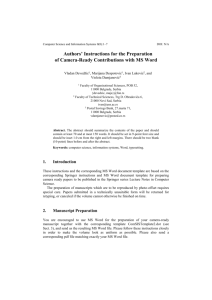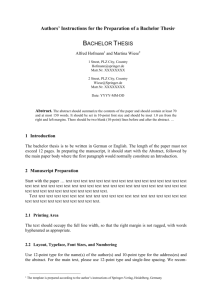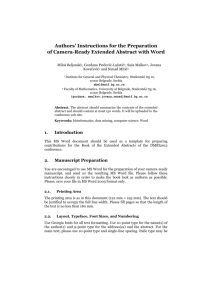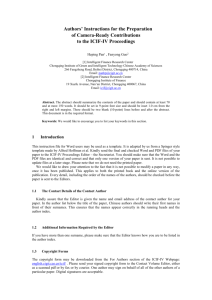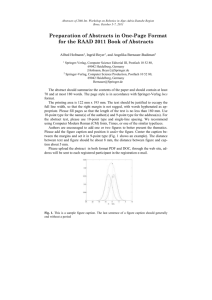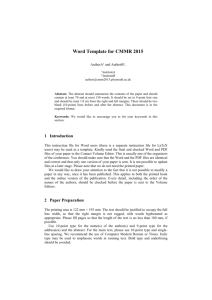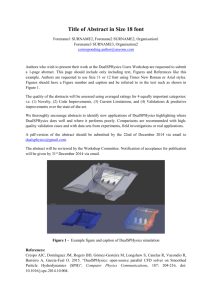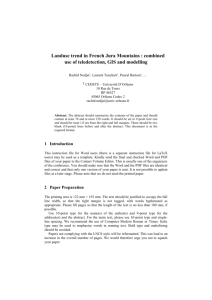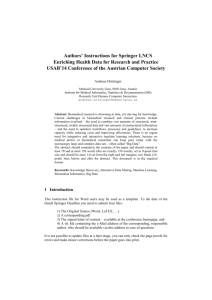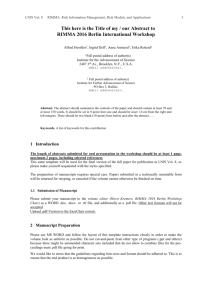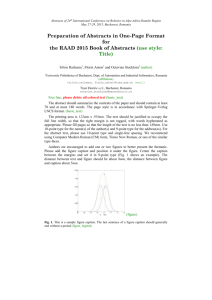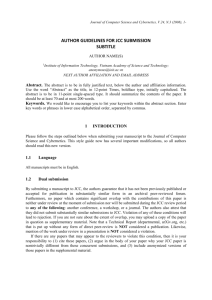Lecture Notes in Computer Science:
advertisement
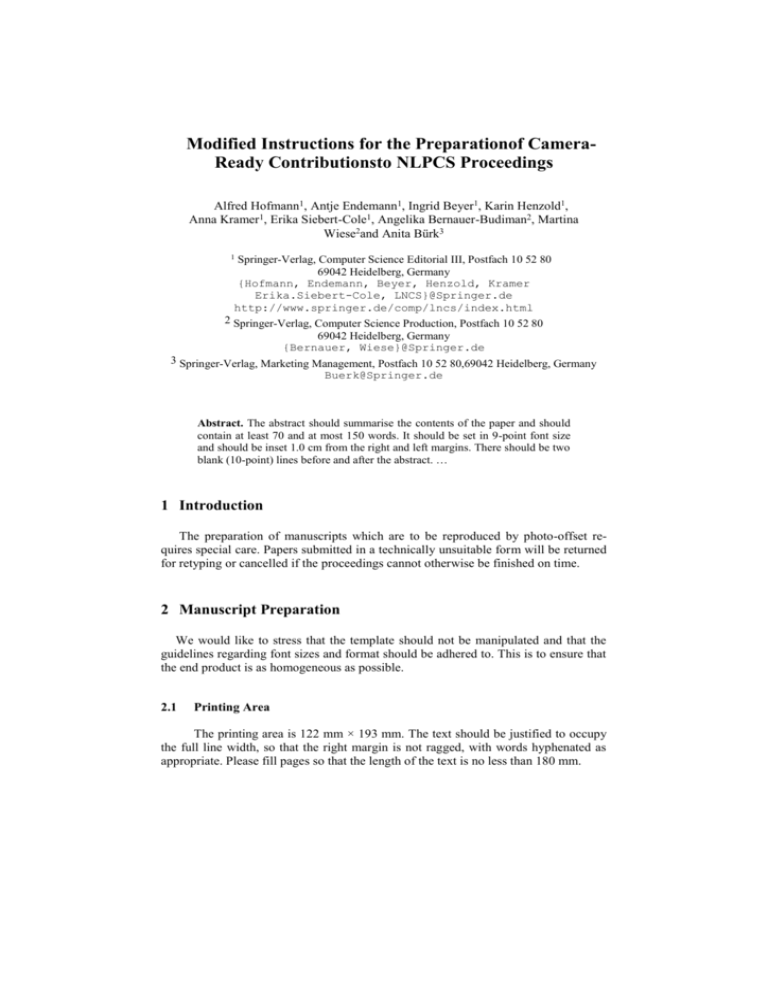
Modified Instructions for the Preparationof CameraReady Contributionsto NLPCS Proceedings
Alfred Hofmann1, Antje Endemann1, Ingrid Beyer1, Karin Henzold1,
Anna Kramer1, Erika Siebert-Cole1, Angelika Bernauer-Budiman2, Martina
Wiese2and Anita Bürk3
1
Springer-Verlag, Computer Science Editorial III, Postfach 10 52 80
69042 Heidelberg, Germany
{Hofmann, Endemann, Beyer, Henzold, Kramer
Erika.Siebert-Cole, LNCS}@Springer.de
http://www.springer.de/comp/lncs/index.html
2 Springer-Verlag, Computer Science Production, Postfach 10 52 80
69042 Heidelberg, Germany
{Bernauer, Wiese}@Springer.de
3 Springer-Verlag, Marketing Management, Postfach 10 52 80,69042 Heidelberg, Germany
Buerk@Springer.de
Abstract. The abstract should summarise the contents of the paper and should
contain at least 70 and at most 150 words. It should be set in 9-point font size
and should be inset 1.0 cm from the right and left margins. There should be two
blank (10-point) lines before and after the abstract. …
1 Introduction
The preparation of manuscripts which are to be reproduced by photo-offset requires special care. Papers submitted in a technically unsuitable form will be returned
for retyping or cancelled if the proceedings cannot otherwise be finished on time.
2 Manuscript Preparation
We would like to stress that the template should not be manipulated and that the
guidelines regarding font sizes and format should be adhered to. This is to ensure that
the end product is as homogeneous as possible.
2.1
Printing Area
The printing area is 122 mm × 193 mm. The text should be justified to occupy
the full line width, so that the right margin is not ragged, with words hyphenated as
appropriate. Please fill pages so that the length of the text is no less than 180 mm.
2.2
Layout, Typeface, Font Sizes and Numbering
Use 10-point type for the name(s) of the author(s) and 9-point type for the address(es) and the abstract. For the main text, please use 10-point type and single-line
spacing. We recommend using Computer Modern Roman (CM) fonts, Times, or one
of the similar typefaces widely used in photo-typesetting. (In these typefaces the letters have serifs, i.e. short endstrokes at the head and the foot of letters). Italic type
may be used to emphasise words in running text. Bold type and underlining should be
avoided. With these sizes, the interline distance should be set so that some 45 lines
occur on a full-text page.
Headings should be capitalised (i.e., nouns, verbs, and all other words except
articles, prepositions, and conjunctions should be set with an initial capital) and
should, with the exception of the title, be aligned to the left. Words joined by ahyphen
are subject to a special rule. If the first word can stand alone, the second word should
be capitalised. The font sizes are given in Table 1.Here are some examples of headings: "Criteria to Disprove Context-Freeness of Collage Languages", "On Correcting
the Intrusion of Tracing Non-deterministic Programs by Software", "A User-Friendly
and Extendable Data Distribution System", "Multiflip Networks: Parallelizing GenSAT", "Self-determinations of Man".
Lemmas, Propositions, and Theorems. The numbers accorded to lemmas,
propositions, and theorems etc. should appear in consecutive order, starting with the
number 1, and not, for example, with the number 11.
Table 1. Font sizes of headings. Table captions should always be positioned
above the tables. The final sentence of a table caption should end without a period.
Heading level
Example
Font size and style
Title (centred)
14 point, bold
Lecture Notes …
1st-level heading
2nd-level heading
3rd-level heading
4th-level heading
2.3
1 Introduction
2.1 Printing Area
Headings. Text follows …
Remark. Text follows …
12 point, bold
10 point, bold
10 point, bold
10 point, italic
Figures and Photographs
Please produce your figures electronically, if possible, and integrate them into your
text file.
Check that in line drawings, lines are not interrupted and have constant width.
Grids and details within the figures must be clearly readable and may not be written
one on top of the other. Line drawings should have a resolution of at least 800 dpi
(preferably 1200 dpi). For digital halftones 300 dpi is usually sufficient. The lettering
in figures should have a height of 2 mm (10-point type). Figures should be scaled up
or down accordingly. Please do not use any absolute coordinates in figures. If possible, the files of figures (e.g. PS files) should not contain binary data, but be saved in
ASCII format.
If you cannot provide your figures electronically, paste originals into the manuscript and centre them between the margins. For halftone figures (photos), please
forward high-contrast glossy prints and mark the space in the text as well as the back
of the photos clearly, so that there can be no doubt about where or which way up they
should be placed.
Figures should be numbered and should have a caption which should always be
positioned under the figures, in contrast to the caption belonging to a table, which
should always appear above the table. The final sentence of a caption, be it for a table
or a figure, should end without a period. Please centre the captions between the margins and set them in 9-point type (Fig. 1 shows an example). The distance between
text and figure should be about 8 mm, the distance between figure and caption about 5
mm.
Fig. 1. One kernel at xs (dotted kernel) or two kernels at xi and xj (left and right)
lead to the same summed estimate at xs. This shows a figure consisting of different
types of lines. Elements of the figure described in the caption should be set in italics,
in parentheses, as shown in this sample caption. The last sentence of a figure caption
should generally end without a period
If you have to insert a pagebreak before a figure, please ensure that the previous
page is completely filled.
Remark 1.In the printed volumes, illustrations are generally black and white (halftones), and only in exceptional cases, and if the author is prepared to cover the extra
cost for colour reproduction, are colour pictures accepted. If colour illustrations are
necessary, please send us colour-separated files if possible. Colour pictures are welcome in the electronic version at no additional cost.
Remark 2.To ensure that the reproduction of your illustrations is of reasonable
quality we advise against the use of shading. The contrast should be as pronounced as
possible. This particularly applies for screenshots.
2.4
Formulas
Displayed equations or formulas are centred and set on a separate line (with an
extra line or halfline space above and below). Displayed expressions should be numbered for reference. The numbers should be consecutive within each section or within
the contribution, with numbers enclosed in parentheses and set on the right margin.
For example,
x+y=z.
(1)
Please punctuate a displayed equation in the same way as ordinary text but with a
small space before the end punctuation.
2.5
Program Code
Program listings or program commands in the text are normally set in typewriter font, e.g., CMTT10 or Courier.
Example of a Computer Program from Jensen K., Wirth N. (1991) Pascal user manual
and report. Springer, New York
program Inflation (Output)
{Assuming annual inflation rates of 7%, 8%, 10);
const MaxYears = 10;
var
Year: 0..MaxYears;
Factor1, Factor2, Factor3: Real;
begin
Year := 0;
Factor1 := 1.0; Factor2 := 1.0; Factor3 := 1.0;
WriteLn('Year 7% 8% 10%'); WriteLn;
repeat
Year := Year + 1;
Factor1 := Factor1 * 1.07;
Factor2 := Factor2 * 1.08;
Factor3 := Factor3 * 1.10;
WriteLn(Year:5,Factor1:7:3,Factor2:7:3,
Factor3:7:3)
until Year = MaxYears
end.
2.6
Footnotes
The superscript numeral used to refer to a footnote appears in the text either directly after the word to be discussed or – in relation to a phrase or a sentence – fol-
lowing the punctuation sign (comma, semicolon, or period). Footnotes should appear
at the bottom of the normal text area, with a line of about 2cm in TeX and about 5cm
in Word set immediately above them. 1
2.7
Citations
The list of references is headed “References” and is not assigned a number in
the decimal system of headings. The list should be set in small print and placed at the
end of your contribution, in front of the appendix, if one exists. Please do not insert a
page break before the list of references if the page is not completely filled. An example is given at the end of this information sheet. Citations by name and year should
adhere to the following examples: Miller (1998), Miller and Smith (2001), Miller et
al. (1999), Miller (1998a, 2010b).
2.8
Page Numbering and Running Heads
Your paper should show no printed page numbers; these are allocated by the
volume editor.
2.9
Printing Quality
For reproduction we need sheets which are printed on one side only. Please use a
high-resolution printer, preferably a laser printer with at least 300 dpi. We prefer the
text to be centred on the pages (i.e., equal margins left and right and top and bottom).
The format of the paper (A4, Letter, etc.) is irrelevant.
3 Supplementary Material
If you wish to include colour illustrations in the electronic version in place of or in
addition to any black and white illustrations in the printed version, please provide the
volume editors with the appropriate files.
If you have supplementary material, e.g., executable files, video clips, or audio recordings, on your server, simply send the volume editors a short description of the
supplementary material and inform them of the URL at which it can be found. We
will add the description of the supplementary material to the NLPCS website and
create a link to your server. Alternatively, if this supplementary material is not to be
updated at any stage, then it can be sent directly to the volume editors, together with
all the other files.
1The
footnote numeral is set flush left and the text follows with the usual word spacing. Second and subsequent lines are indented. Footnotes should end with a period.
4 Checklist
When submitting your camera-ready manuscript to the secretariat, please make
sure it is submitted as a Word document (preferable .docx) and you include the following:
a single-sided printout (not a photocopy) of the final version of your contribution,
your source (input) files, e.g. TEX files for the text and PS or EPS files for the
figures.
If supplementary material is available, please provide the volume editors with
a short description of the supplementary material,
the supplementary material or the URL at which it can be found,
the files of colour figures for the electronic version.
References
Journal Paper
Salomon, G. (1996) Unorthodox Thoughts on the Nature and Mission of Contemporary Educational Psychology. Educational Psychology Review, 8(4):397-417.
Book chapter, or an article within a book
Lou, M. W. (1988) The history of language use in the education of the Deaf in the
United States. In: Strong, M. (Ed) Language, Learning and Deafness, pp. 75-98.
Cambridge University Press, New York.
Complete book, authored
Strong, M. (ed) Language, Learning and Deafness. Cambridge University Press, New
York.
Proceedings as a book
Neustein, A. (2012) Think before You Talk: The Role of Cognitive Science in Natural
Language Processing. In: Sharp, B. and Zock, M. (Eds) Proceedings of the 9th International Workshop on Natural Language processing and Cognitive Science,
Wroclaw, Poland, 28 June -1st July 2012, pp. 3-11.
Dissertation
Case, D. (2012) An Animated Pedagogical Agent for Assisting Novice Programmers
within a Desktop Computer Environment, Staffordshire University, UK.
In press article
Major, M. (2015) Recent developments. In: Jones, W. (Ed) Surgery today. Springer,
Dordrecht (in press).
Online document
Doe, J. (1999) Title of subordinate document. In: The dictionary of substances and
their effects. Royal Society of Chemistry, http://www.rsc.org/dose/title of subordinate
document. Accessed 15/1/1999.
